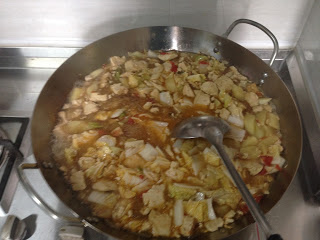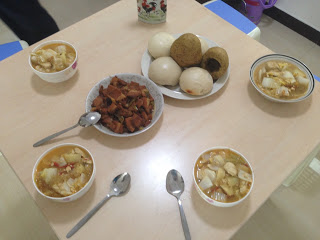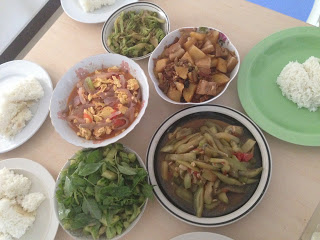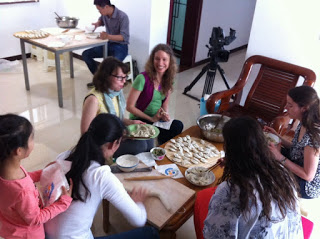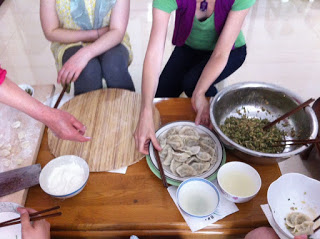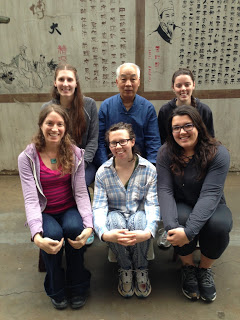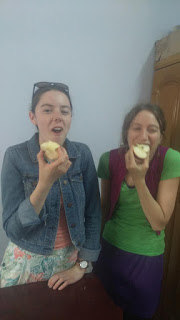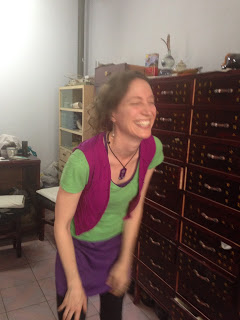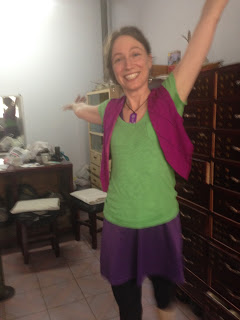Greetings Friends!!
YAY!!!
I LOVE being in China!!! I still am not sleeping past 4:30 a.m. yet (due to excitement and jet lag…and the fact that it’s almost the summer solstice and the sun rises here before 5:15 a.m.) But I enjoy getting up, greeting the day with qigong practice while the sparrows flutter and hop around on the roof top outside my window, and sometimes I even start dancing around in my PJs…just because… I’m in CHINA!!! Haha! 🙂
Being of Service & the bridge of interpretation
And I love speaking Chinese and being of service! It’s so fun being an interpreter, especially for these wonderful young women! I love how interpreting helps create a bridge between people and cultures through language, love and understanding. It facilitates other people’s own experience of this wonderful place, the rich culture, the wisdom and, in this case, the treasures of Chinese medicine and the great gift of knowing and learning with Dr. Zhao and his family. Each day, Dr. Zhao is covering a variety of the fundamentals of this medicine and treatment. We’ve discussed the methods of diagnosis (wang, wen, wen, qie 望闻问切 - which is looking, hearing/smelling, asking and pulse-taking (I’ll go into more details on 1 or more of these later :)), acupuncture with Dr. Zhao’s patient with Bells Palsy, cupping (for which I got my stomach cupped!! A first for me! :)), acupressure, Chinese herbs and shufa – Chinese calligraphy! 🙂 It’s all sooooo fun and such a very new world for these 4 students!
It’s also been exciting for both me and Dr. Zhao to realize how much my Chinese has improved and my knowledge of Chinese medicine in the last 6 years! My first 2-month internship with him was AMAZING!! And it was a steep learning curve on so many levels – such as learning his methods of acupressure, how to recognize the medicinal herbs AND how to use the Chinese herb hand scales AND wrap packages! 😛 I was pretty clumsy at that! It was also learning the meridians and points in Chinese, learning more history of the medicine, of Dr. Zhao and his family, cultural norms and practices, how to understand Henan dialect, Chinese cooking and more! And, regarding Chinese cooking, I still have only semi-mastered 1 dish!! 😛 That being the “macaroni and cheese staple” of Chinese family dinners which is stir-fried eggs and tomatoes :)! BUT the last several days Ayi has also been giving us “Chinese cooking” – where we are observing and note-taking how she prepares our delicious lunches. 🙂 YAY!!
The Bounty of Yumminess in China!
I don’t think I mentioned yet that Dr. Zhao and Ayi have graciously invited me and our 4 students to eat lunch with them everyday!!! This means we have a most amazing yummy Chinese breakfast at the hotel in the morning and dinner at night, AND then at noon, we have an epically delicious lunch/feast with the Zhaos!! Can you tell I LOVE the food here?! 🙂 Just today, we had steamed rice with oh-so-yummy stir-fried tofu noodles with greens, cucumber salad with tahini sauce, eggplant and tomatoes, sliced pork with some long, thin green veggie (how’s that for being specific! :-P) I swear China has more veggies here than we do in the States!! :)) and a delicious greens and egg drop soup to complete the feast!
With Dr. Zhao smiling and serving me a mountain of white rice on his biggest plate, and then Ayi reminding me and all the students to “duo chi yidian” “eat more!” while pointing to the various yummy dishes, we all are definitely eating very well! 🙂
Dumplings & the return of reporters!
The other day, Ayi also showed us all how to “bao jiaozi” – make Chinese dumplings!! Yummy! Even though I can’t eat the doughy part due to a gluten allergy, I ate plenty of the dumpling insides (YUM!!!), AND Jumin, Dr. Zhao’s daughter-in-law, made me a huge bowl of scrumptious sautéed rice noodles, egg and greens! 🙂 I have a lot of pics from this event….and, if you look in the background of one of the pics….you’ll see a camera and a reporter! Yes!!! Once again, (and I’m not sure how this happens!!!), some reporters came to interview me and the 4 students, film us in the clinic and their home making “jiaozi” with Ayi! 🙂 The also followed us on one of our weekend outings! This time it wasn’t the TV station or newspaper who came, it was 中国报导 Zhong Guo Bao Dao, the government’s informational website on China! I’ll send you a link to the film/video they produce once it’s done! 🙂
Back to the Clinic
So! Back to the clinic and our studies 🙂 In my last blog (travel update 2), I shared some fun pics of our time that give you a visual sense of the excitement and curiosity of these students and the fun that we’re all having learning and studying together! Dr. Zhao is having a blast too!! He said it’s very enlivening to have such young, bright students to share with!!
4 Parts of Diagnosis
In the 4 parts of diagnosis I mentioned, Dr. Zhao first spoke of “wang” – the art of looking, of seeing. A master doctor, he said, quoting an ancient text, is one who “wang er zhi zhi” 望而知治” “sees and knows how to help heal the patient.” A more mediocre doctor is one who “qie er zhi zhi 切而知治” – “feels the pulses and then knows how to help the patient heal.” And, said Dr. Zhao, it’s best that all doctors use all their tools. Dr. Zhao is very humble and while he is a master doctor, he often speaks of his great ancestors, the for-fathers of Chinese medicine with much humbleness, honor and respect and looks to them for his ongoing inspiration.
A Master ~ all areas in One
He also spoke to how there’s some movement in Chinese medicine, just like in Western Medicine, to separate into different areas of specialization, such as women’s health, pediatrics, dermatology, gerontology, psychiatry, gastroenterology, etc. Yet before the Cultural Revolution, there were no specialties. To be a great doctor, you were to be a master of all areas, ages, conditions of medicine. The mastery is in the observing ever layered patterns of disharmony, understanding the cause(s) and discerning what tools, herbal formulas to use to help the patient restore balance.
This mastery is exactly what I see in Dr. Zhao. Every day he has 20-30 patients of all ages, conditions, concerns, and sicknesses. And he sees and treats them all with ease – skin diseases, infertility, heart disease, lung cancer, depression, Bells Palsy, jaundice, sprained ankles, acid reflux, menopause issues, and so much more (this is just a small sample of patient conditions we have witnessed in clinic). Often a whole family will come to see Dr. Zhao all together. For example, in one family, the wife had come when she had trouble getting pregnant. Now they have a beautiful 4-year-old boy, and they all came one day to see Dr. Zhao. The wife had headaches, the husband had injured his ankle, the grandmother was having heart and sleep issues. Dr. Zhao graciously, lovingly and masterfully took care of all of them.
When we took a field trip to Zhang Zhong Jing’s 张仲景 burial site and temple, there was one temple room with a statues enacting a day in Zhang Zhong Jing’s clinic. (Zhang Zhong Jing one of the great fore-fathers in Chinese Medicine and is responsible for compiling many centuries of medical writings and writing the Shang Han Bing Lun – the treatise on cold diseases – a text of many formulas that have been used for centuries and are used today every Chinese Medicine school worldwide). This scene depicted a simple room with patients of all different ages, classes, vocations, and conditions coming to see him for assistance. I told Dr. Zhao it looked just like him and his clinic. And he beamed! 🙂
I love the variety of experiences and teachings Dr. Zhao is giving us on this trip!! It has been super full, and with doing interpretation work 12+ hours/day it’s been a lot and very fun….though, it also means I’ve had little time for writing.
In the past, I’ve invested more of my time learning the acupressure techniques, working with the herbs, observing him working with patients and SLOWLY reading some of his medicine books (that are all in Chinese, of course – and hence the emphasis on SLOW! :-P) This time, though, since we have a relatively short period of time, AND all these students are new to Chinese medicine, he has been covering such a fun variety!! We do have plenty of observation time where I translate what’s going on between Dr. Zhao and the patient, where we can also start to feel and discern the pulses, and observe the different healing techniques being used. During the occasional lulls with no patients, he starts sharing all sorts of fascinating basics regarding Chinese medicine.
Bingyin ~ the causes of Illness
For example, I mentioned that we went over all the 4 main ways of diagnosis (looking/seeing, hearing/smelling, asking, pulse-taking – and while I haven’t gone into all of these areas, each is fascinating!!! Pulses alone have about 27 differentiations and help you know what if any organs are stressed, whether the illness is more internal or external, has heat or cold and so, so much more.) We also covered “bing yin 病因” – the causes of illness, which are grouped into “neiyin内因” and “waiyin外因” – internal and external causes. The internal causes are grouped into 2 types of xingwei行为 – actions or behavior. One is changes to emotions/spirit (jingshen bianhua), and another is “bu hao de shenghuo xiguan” – bad daily life habits. In terms of emotions/spirit changes, Dr. Zhao listed 5 main ones, though sometimes in qigong and other places, we refer to the “7 negative emotions”. While all emotions are natural and can help us keep balance in our lives, if any one emotion is in extreme excess, it can damage our physical body, our organs. Each emotion is related to a certain organ. For example:
- Xi guo shang xin 喜过伤心 – extreme happiness or mania can hurt the heart
- Nu guo shang gan怒过伤肝 – extreme anger can hurt the liver
- Bei guo shang fei悲过伤肺 – extreme sadness can hurt the lungs
- Sulu guo shang piwei思路过伤脾胃 – excessive thinking can hurt the stomach and spleen
- Jing kong guo shang shen惊恐过伤肾 – extreme fear can hurt the kidneys
Some examples of “bu hao” “bad” daily habits would be smoking, drinking too much, going to bed extremely late and/or eating too much of any type of food. For example, there are 5 main flavors: sweet, sour, spicy, salty and bitter. Each type of flavor is beneficial to certain organs, but if we have too much of that flavor, it becomes harmful to that organ. For instance, bitter is good for the heart but too much hurts it. Same is true for spiciness and our lungs, sour and our liver, saltiness and our kidney and sweetness and our stomach and spleen.
Some of the “waiyin” – external causes include nature and the elements, as referred to as liuyin 六淫, such as:
- 風 feng – wind
- 寒 han – cold
- 暑 shu – weather heat, summer heat
- 湿 shi – dampness
- 燥 zao – dryness
- 火 huo – fire – extreme heat
I love how the Chinese language has such succinct ways to express things – often in 4 characters – whereas the same meaning in English is often a whole sentence or two!! I realize this a lot when someone asks me to translate a phrase into English! They laugh and have a look of like, “oh no! How will I ever remember that long sentence!!” while exclaiming, “Zenme nenme chang?!” “How can it be that long?!” One example in referring to what I just shared about the internal/emotions and external/natural causes of illness is: qi qing liu yin 七情六淫 -a simple 4-character phrase that refers to everything I described above :)!
Yay! The magical world of ‘Cao Yao’ – Herbs!
Okay! This update is getting very LONG, BUT I still desire to share some on herbs (cuz they are sooooo cool!!! :-)) and calligraphy! 🙂 So before introducing much about herbs, Dr. Zhao first reviewed understanding the nature of an illness, or bing de xingzhi 病的性质. Is it related to a yin or yang imbalance? Too much cold or heat in the body? A deficiency of some kind, such as of qi or blood? Too much dampness in the body (which could be damp heat or damp coldness)? Is it a condition close to the surface of the body or has the pathogen moved deeper inside?
Once you know the nature of the illness, you can determine whether herbs are a part of treatment. The herbs (of which there are over 400!) all have their own nature (such as hot, warm, cool and cold), affect different meridians and organs, and are grouped into categories for the types of things they do. Some examples include: tonifying qi and/or blood, increasing blood circulation, dispelling dampness, expelling toxins or parasites, etc. Once you know the herbs, it’s a whole mastery, art and skill to then group herbs together to make a formula – as grouping them together can change how they work.
So! This is a really cool part that I just learned on this trip! When making a Chinese herbal formula, different herbs are used to fill 4 different “roles.” These roles make the whole formula work effectively, efficiently and harmoniously in the body. Formulas can be made of more than 4 herbs, as more than 1 herb can take on the various roles. So, what are these roles, you may ask? (Or at least I did, eagerly sitting on the edge of my seat as Dr. Zhao explained this!! :)) They are: Jun Chen Zuo Shi 君臣佐使.
Jun is like the Emperor or President (as Dr. Zhao said, the “Obama congtong”) of the formula. Jun is the leader of the main aim/purpose of the formula. Chen and Zuo are helpers and assistants making the wishes/aims of the President happen. And Shi is the harmonizer, making sure all the herbs work together harmoniously and in harmony in the body. Gancao, licorice root is one commonly used harmonizer in many formulas. 🙂 This is so cool!
Well! See? While some of you receiving this are already Chinese doctors, please excuse the simplicity of my explanations, and for those of you new to Chinese medicine, I hope you enjoyed this recount of some foundations of Chinese medicine and some of the awesome things we’re learning in Dr. Zhao’s lovely clinic! It is a system of medicine with 1,000s of years of history, and it comes from a deep understanding of Life, the cycles and balance of Nature and a respect and reverence for the life’s mystery and wisdom.
A greeting through the Eastern ‘pen’ – (Maobi – calligraphy brush)
Almost done! 🙂 I just also desire to share briefly about calligraphy! 🙂 During our first morning in clinic, Dr. Zhao took out his “maobi” calligraphy brush and rice paper and began to write. His characters are beautiful – it is said you can tell a person’s skill and qi through their “shufa” – their calligraphy. It is an art, meditation and skill. And writing calms the mind and heart. Dr. Zhao smiled, his being beaming as he wrote. It was a welcome letter that said, “Relie huanying Jianada tongxue lai wo suo fangxue, hai you Meiguo de Kailun Nushi!” A warm, enthusiastic greeting to my Canadian students who have come here to study, and also to American Ms. Kailun! 🙂 (I included a pic of this in my Travel Update 2.) After giving us each a turn copying his beautiful characters with his brush, he began to write some well-known Confucian quotes about the importance of friendships, caring for and greeting your guests and the original good nature of all beings.
One Confucian quote he wrote was:
禮義任智信 Li Yi Ren Zhi Xin
Each character refers to a 2-character word. Li refers to limao 禮貌, or courtesy and politeness. Yi refers to qingyi 情義, or the ties of friendship. Ren refers to renai 仁愛, or ones love for humanity. Zhi refers to zhihui 智慧, or wisdom. And Xin refers to chengxin 誠信, or sincerity or honesty. See how in just 5 characters, Confucius in giving a whole discourse on the importance of friends, caring for ones guests and a guide to living our good nature and a fulfilling life? 🙂
Then he wrote another quote: 人之初性本善Ren zhi chu xingben shan. “Our human nature at birth is good.” He said he can feel this goodness/ kindness so strongly in all of us and is part of why we all felt an instant trust, resonance and friendship with each other.
Oh my goodness!!! What a long update!!! And I have so many pics too! Thank you to all of you who have made it this far!! 🙂 It means so much for me to share. Writing is one way I love to pay forward these gifts I’m receiving! 🙂 If you didn’t receive my Travel Update 2, let me know and I’ll resend it to you. I’ve been having some trouble with my gmail account and some messages not sending.
Below are a few more funny pics of Brynn and I laughing and eating a yummy apple Junling gave us. Who knew eating an apple could be so funny?! 😀 And then Junling took my camera and started snapping pics of me and we got some together too — she’s been my dear friend/sister now for 6 years!! 🙂
So much BIG LOVE to you All!! Yay!!!
Love,
Kailun


